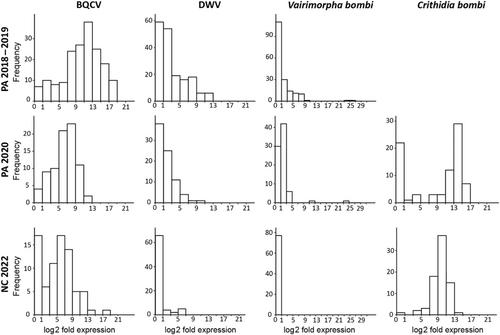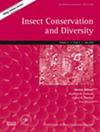景观因素在形成近北极东部地区熊蜂病原体负荷中的作用
IF 3.2
2区 农林科学
Q1 ENTOMOLOGY
引用次数: 0
摘要
病原体和寄生虫是导致熊蜂数量下降的原因。它们的数量会受到许多非生物和生物因素的影响,因此管理这些蜜蜂的疾病需要了解这些因素对病原体负荷的相对影响。我们评估了大黄蜂(Bombus impatiens)和蜜蜂(Apis mellifera)中黑蜂王细胞病毒(BQCV)和畸形翅病毒的载量,以及大黄蜂中寄生虫Vairimorpha bombi和Crithidia bombi的载量。根据土地覆盖、花卉质量、蜜蜂多样性和天气等指标对病原体负荷进行了评估。研究结果与美国宾夕法尼亚州的类似数据以及北美其他有关熊蜂的景观研究结果进行了比较。与宾夕法尼亚州相比,北卡罗来纳州熊蜂病原体负荷的空间变化较小,这降低了检测景观效应的能力。例如,Crithidia相当普遍,而Vairimorpha则未检测到。来自这两个州的数据显示,已开发土地和蜜蜂与病毒载量(尤其是 BQCV)呈最一致的正相关,而森林和筑巢栖息地的可用性通常与病毒载量呈负相关。多变量模型仅支持北卡罗来纳州熊蜂夏季花卉资源与 BQCV 病毒量之间的正相关关系。结合更广泛的文献,这些数据表明,发达土地和蜜蜂的水平与病原体负荷的增加关系最大,而花卉资源和蜜蜂群落组成则显示出更多的环境依赖性影响。本文章由计算机程序翻译,如有差异,请以英文原文为准。


The role of landscape factors in shaping bumble bee pathogen loads across regions of the eastern Nearctic
求助全文
通过发布文献求助,成功后即可免费获取论文全文。
去求助
来源期刊
CiteScore
7.70
自引率
8.60%
发文量
58
审稿时长
>12 weeks
期刊介绍:
To publish papers of the highest scientific quality within the general area of insect (and other arthropods) conservation and diversity covering topics ranging from ecological theory to practical management.
Papers are invited on the following topics: Conservation genetics; Extinction debt; Long-term conservation planning and implementation; Global implications of local or national conservation actions; Management responses of species and communities; Captive breeding programs; Comparisons of restored and natural habitats; Biogeography; Global biodiversity; Metapopulation dynamics; Climate change: impacts on distributions and range; Invasive species: impacts and control; Effects of pollution; Genetic threats to diversity by introgression; Effects of fragmentation on diversity and distribution; Impact of agricultural and forestry practices on biodiversity; Enhancing urban environments for diversity and protection; Biodiversity action plans: can we scale up from insects?; Effectiveness and choice of indicator species; Soil biodiversity and interactions with above-ground biodiversity; Ecological interactions at local levels; Ecological and evolutionary factors influencing diversity and local, regional and global scales; Sustainable livelihoods and training on the ground; Integrating science and policy.

 求助内容:
求助内容: 应助结果提醒方式:
应助结果提醒方式:


